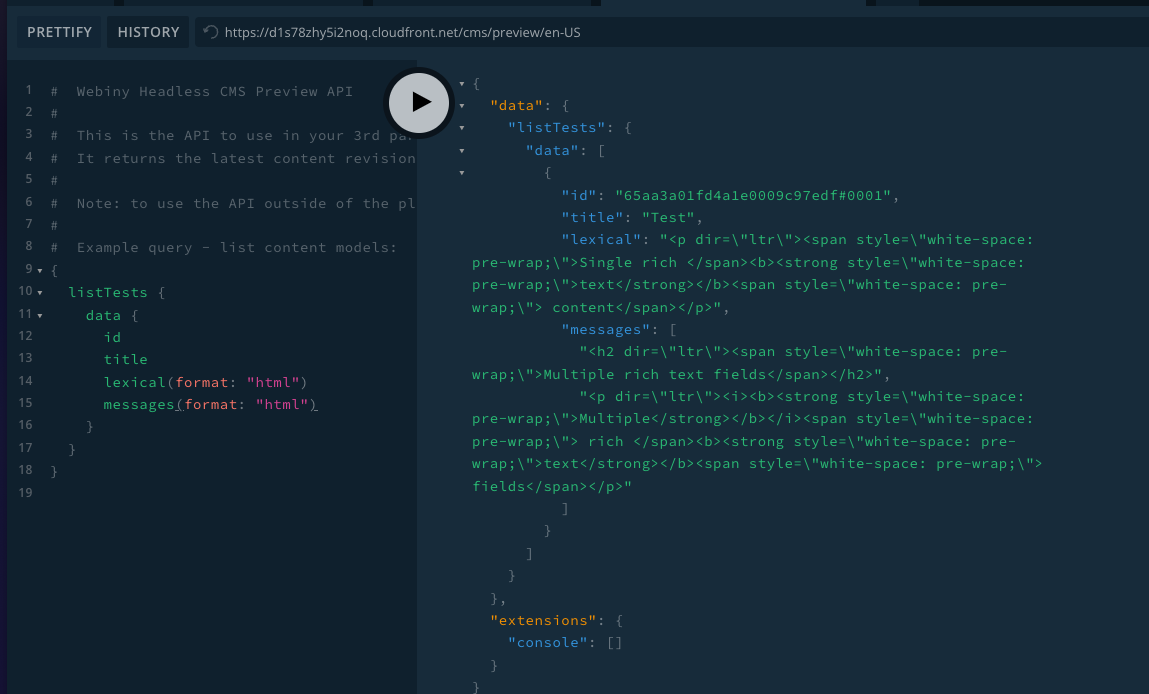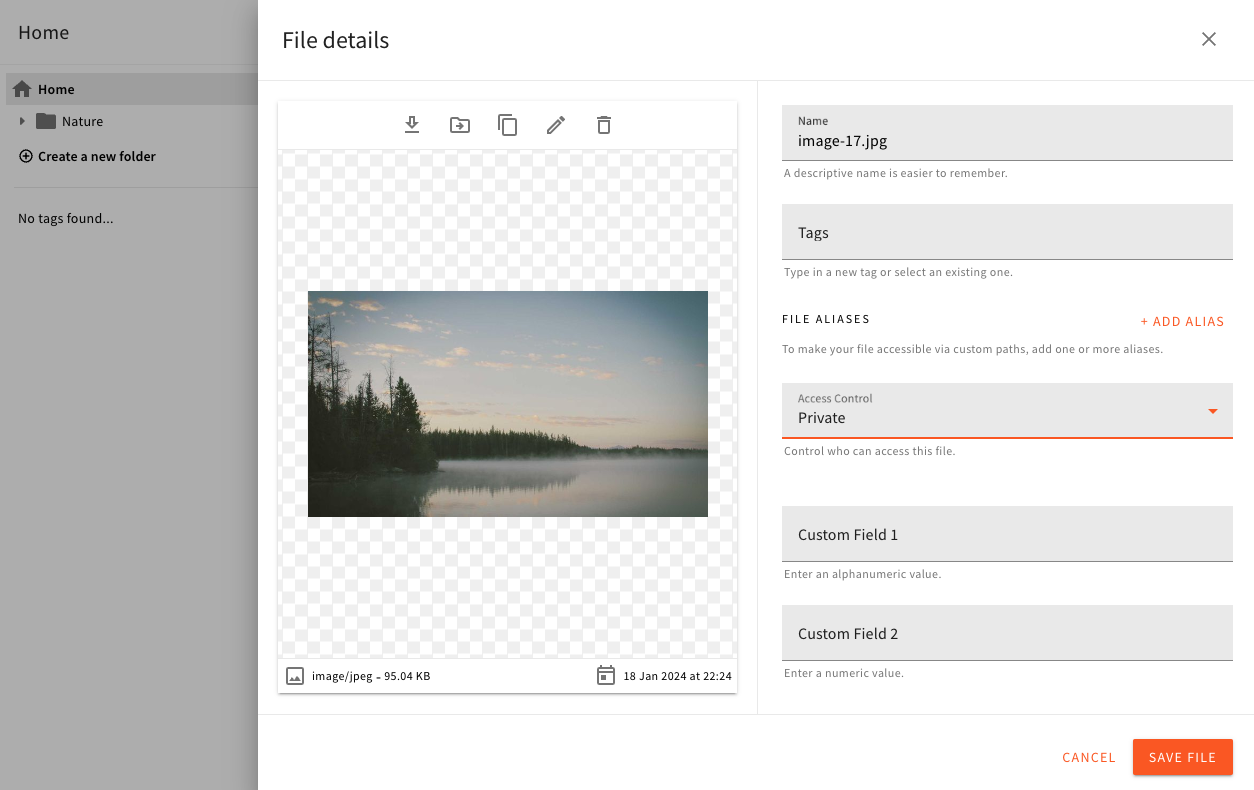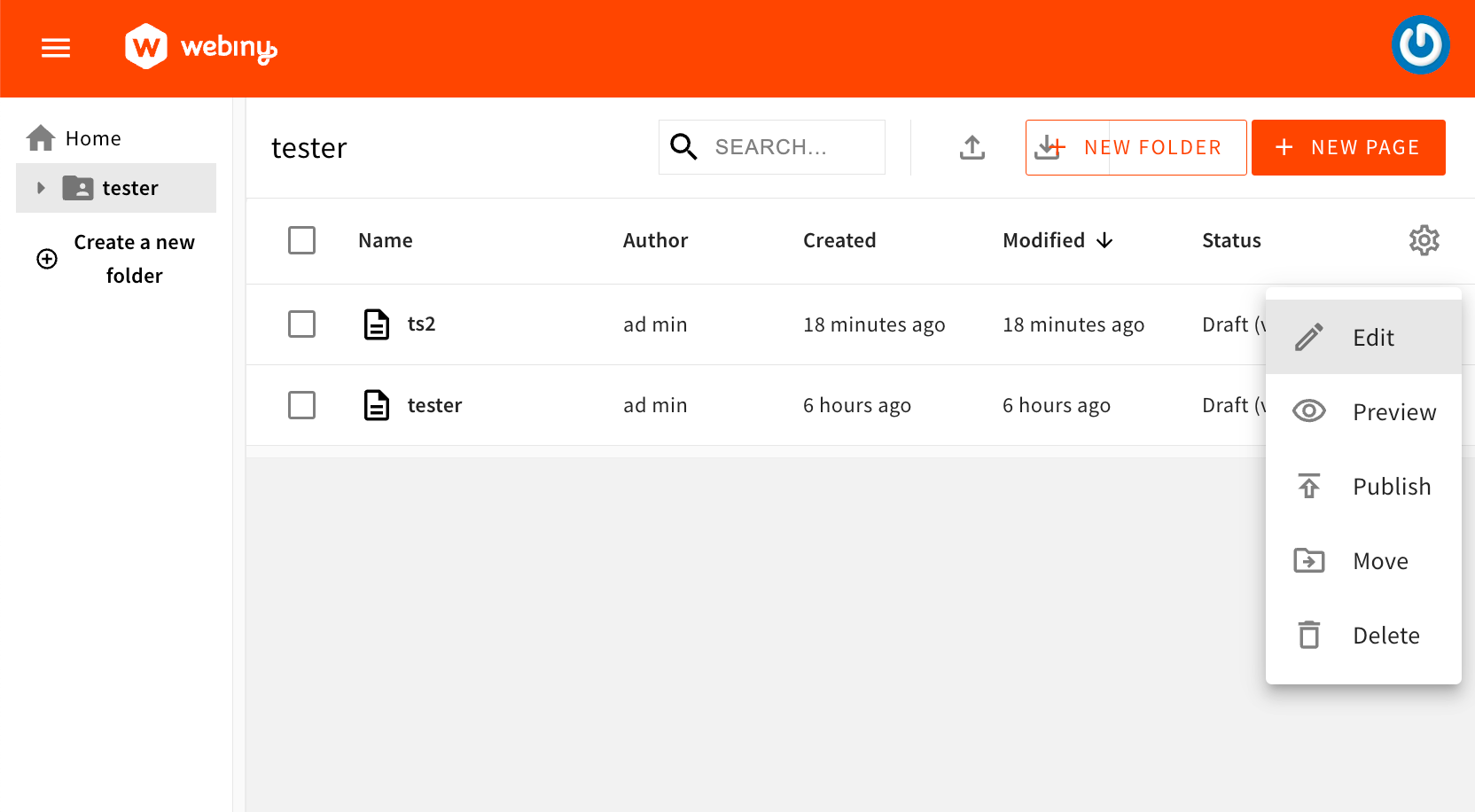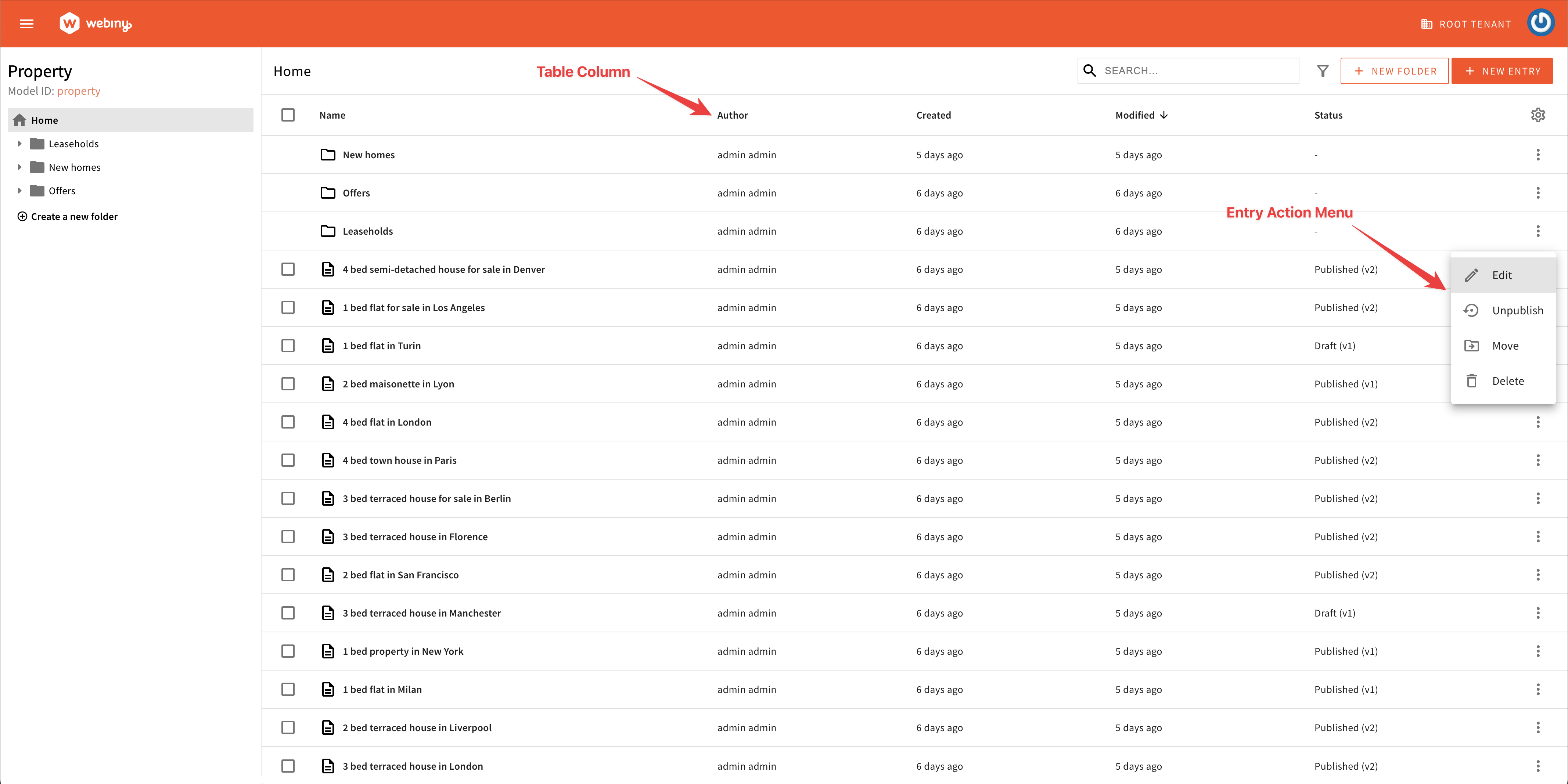Release Notes > Older Releases > 5.39.0
Webiny 5.39.0 Changelog
January 30, 2024
 release on GitHub.
release on GitHub.Breaking Changes❗
Headless CMS - Revamped Date/Time and Identity (On/By) Meta Fields
With Webiny’s Headless CMS, created content entries include the following date/time and identity-related meta fields:
| Field | Description |
|---|---|
createdOn | The date/time when an entry revision was created. |
savedOn | The date/time when an entry revision was last saved. |
publishedOn | The date/time when an entry revision was published. |
createdBy | The identity of the user who created an entry revision. |
ownedBy | The identity of the user who owns the entry (who created the first revision). |
modifiedBy | The identity of the user who last modified an entry revision. |
And while these meta fields are useful, the main issue our users have been facing is that they are all revision-specific, and not entry-specific. As a result, if a user wanted to, for example, display the date/time when an entry was initially created, they had to first retrieve the entry’s first revision, and then display the createdOn meta field from that revision. Definitely not ideal.
On top of that, searching for entries and sorting based on the date/time or identity-related meta fields was also not possible. Because, again, these meta fields are revision-specific, and not entry-specific.
Content entries created with Webiny’s Headless CMS are versioned. In other words, they consist of one or more revisions. For more info, check out the related user guides.
In order to tackle these issues, with this release, we’re revamping the date/time and identity-related meta fields. Essentially, we’re creating two groups of meta fields: revision-specific and entry-specific.
Revision-specific fields contain the revision prefix in their name, and, as the name suggests, they contain revision-level information. For example, the revisionCreatedOn meta field contains the date/time when a revision of a content entry was created.
On the other hand, entry-specific fields do not contain any prefix, and contain entry-level information. For example, the createdOn meta field contains the date/time when an entry was initially created. The value of this field will not change even if the entry is updated or new revisions are created.
For the full list of new meta fields and additional information, please refer to the new Date/Time and Identity (On/By) Meta Fields reference article.
Backwards Compatibility
In order to introduce these improvements, we also had to introduce a couple of breaking changes. For example, because they’re no longer needed, we’ve removed the publishedOn and ownedBy content entry fields. So, if you’re using these fields in your project, you’ll need to update your code accordingly.
Also, note that this release includes a data migration that will automatically migrate all existing content entries to use the new meta fields. The migration is run automatically after the API project application is deployed.
For more information on all of these topics, be sure to check out the Upgrade Guide section and, more importantly, the Date/Time and Identity (On/By) Meta Fields upgrade guide.
Deployments - New IAM Permissions Requirements
Starting with this release, when deploying Webiny, an AWS Step Functions
And despite the fact that, at the moment, the state machine is only utilized internally, this still means that, in order to deploy Webiny successfully, proper AWS Identity and Access Management (IAM)
For additional information, please refer to the Deployments - New IAM Permissions Requirements upgrade guide.
Project Level TS Config
Until this release, we’ve always copied the entire tsconfig.build.json file into user’s projects. Over time, we learned that this is difficult to maintain, and makes it harder to tweak the config without affecting user’s projects.
With this release, you’ll notice that your tsconfig.build.json file now simply extends our default config from @webiny/project-utils. When going through the upgrade process, make sure you transfer any changes you might have made to the new config file. You only need to do this once, since our changes will never again be done on your project tsconfig file.
File Manager - New File Delivery Mechanism
This release marks a big step in how Webiny handles file delivery, in terms of how flexible it now is. Until now, file delivery was a very rigid, hardcoded process, where you could only serve files off S3 without any additional logic, you couldn’t control cache headers, change how files are transformed, none of that.
With this release, we’ve completely rewritten the entire file delivery. The new delivery mechanism is connected to the entire Webiny SDK, and you can now write your own routing, resolution, and delivery logic (including caching and transformation). From within the File Delivery Lambda, you are now free to interact with Headless CMS, Security, or any other Webiny app. Your custom plugins will also exist in the execution context of the File Delivery Lambda function.
After upgrading to 5.39.0, you won’t notice any differences comparing to your current setup. But under the hood, there’s a lot going on, and we will dedicate some documentation articles to explain how you can customize the file delivery.
If you’re just using Webiny without any customizations to the File Manager, just go through the upgrade process, and you’re good to go.
If you’re generating files in the S3 bucket beyond what Webiny does via its File Manager, then we recommend you get in touch with us, and describe your use case, so we can provide guidance on how to configure the routing for your custom files.
Improved API Security and Cookies
To support certain advanced features, like Private Files, we now store the idToken into a wby-id-token cookie on the API domain, when a user logs into the Admin app. This allows us to perform authentication even without sending the Authorization header (which is not even possible when we talk about plain GET requests issued by the browser, and not AJAX requests). To make this possible, we had to tighten the configuration of headers on the OPTIONS request, and be very explicit about what headers we allow to be sent to the API.
All custom headers, if you have any, now need to be whitelisted! Drop us a line on Slack if you need to customize response headers, and we’ll point you in the right direction.
Headless CMS
Add Support for Rich Text Field Output Renderers (#3835 )
)
Rich text content has always been a challenge to handle, and it very much depends on the requirements of each particular project. Webiny uses Lexical Editor
To make it easier to consume the data delivered through our Headless CMS, we’ve added support for rich text field renderers on the API side. By default, we provide HTML output for the default Lexical editor, but you can decorate the default implementation, and even add a custom one. You might even want to output Markdown, which is now possible.
 Headless CMS - RTE Field Output as HTML
Headless CMS - RTE Field Output as HTMLEdit File in Content Entry Form (#3823 )
)
As a content creator, you can now jump right into the File Details Drawer from the Content Entry form. When you hover over a file preview, you’ll now find a small pencil icon, which will load the file data, and open the drawer. This is the same drawer you see in the main File Manager view, but this way, it’s easier to jump to the file editing, without wasting time on file lookup.
File Manager
Introducing Private Files
Private Files is a new feature, which is a part of the Advanced Access Control Layer (AACL) set of features, available with the Webiny Enterprise license. This feature allows you to protect the files, managed via the File Manager, from unauthorized access.
In this first iteration of the feature, a file can either be public, or private. Files set to private will require a valid identity to be present in the request. To keep track of the user’s credentials, we’re storing the idToken, which is otherwise sent via HTTP headers, into a cookie, set on the API domain.
 File Manager - Access Control
File Manager - Access ControlPage Builder
Increased Memory Size for Export/Import Related AWS Lambda Functions
Prior to this release, the AWS Lambda functions that were used for exporting and importing Page Builder pages, blocks, and templates were using the default memory size of 128 MB. With this release, we’ve increased the memory size to 512 MB.
This change was necessary because, in some cases, the default memory size was not enough to handle the export/import process, which resulted in the process failing.
Fixed List of Actions Shown to Users (#3825 )
)
Prior to this release, some of the page-related actions shown in the list of pages would be shown to users, despite the fact that they didn’t have the required folder level permissions to perform those actions. Page Builder - ACO Actions
Page Builder - ACO ActionsWith this release, we’ve fixed this issue, and now, the list of actions shown to users is based on the permissions they have for the folder in which the page is located.
Admin
Introducing Table Customization APIs (#3756 #3721
#3721 #3785
#3785 )
)
In this latest release, we have introduced powerful APIs that allow developers to customize the tables used by our suite of applications, such as Headless CMS, Page Builder, and File Manager.
Using these APIs, developers can now easily add new columns, replace existing ones, remove them, or reposition them as per their requirements. Additionally, they can also add, replace, remove, or reposition entries and folder actions.
 Headless CMS - Table Columns and Actions
Headless CMS - Table Columns and ActionsDrawerLeft and DrawerRight Components (#3778 )
)
Webiny uses the Material Design drawers in many modules of the system. The main issue with them is that, by design, they’re meant to only be used on the left side of the screen. But from the UX perspective, it’s sometimes beneficial to have them open on the right side (like the File Details drawer, for example).
To make it easy for the core team, but also other developers, to create drawers on both sides of the screen, we’ve now exported two new components DrawerLeft and DrawerRight, and we handle the technical implementation and positioning of those.
To find more details and code samples, visit the PR
Deployments
Introducing Support for Amazon OpenSearch Service (#3612 )
)
With this release, we’re introducing support for Amazon OpenSearch Service

Upon creating a new Webiny project, users will no longer be able to select the DynamoDB + Elasticsearch database setup. Instead, they will be able to select the DynamoDB + OpenSearch setup.
Note that all existing projects that are using the Amazon DynamoDB + Amazon Elasticsearch database setup will continue to work as before. Users’ projects will still be able to use the Amazon Elasticsearch Service, and they will not be forced to migrate to Amazon OpenSearch Service.
Finally, note that, at the moment, we do not provide a migration path from Amazon Elasticsearch Service to Amazon OpenSearch Service for existing projects. Drop us a message in our Community Slack
Visit the Different Database Setups article to learn more about the different database setups Webiny supports.
Other Improvements
Node.js V18 (#3561 )
)
With this release we have updated the system to Node.js v18. Unfortunately, there are some breaking changes coming with the dependency updates:
aws-sdkhas been bumped to3.425.0- because thev2.x.xdoes not work with the Node.jsv18dynamodb-toolboxhas been bumped to0.9.2- because the previous version we were using, does not work withaws-sdkv3.x.x
This was quite an update, with over 750 files changed in our repository, so if you encounter any issues - please let us know. Also, you’ll notice that we now have a package for interacting with the AWS SDK, called @webiny/aws-sdk. This package only exports AWS clients that we actually use in Webiny.
In Node.js 18.x runtime, the default AWS SDK version is v3. See the official AWS blog
We’ve updated our webpack bundling config to follow this change. This means that aws-sdk@2 is no longer excluded from bundling. Instead, @aws-sdk/* packages are now excluded from bundling, since these are always available in the Lambda runtime.
Multi-Event Handler (#3710 )
)
Until this release, the Lambda Handler was only able to handle a single type of the event.
For example, if you wanted to have a Lambda function which handled the S3 event, you had to import the createHandler function from @webiny/handler-aws/s3.
From now on, for all AWS events we support, you can use the createHandler function from @webiny/handler-aws package.
You can still use the old way of importing specific handler factories (s3, dynamodb, etc…), so this change is completely backwards compatible.
To find out more about our Lambda event handlers, please read this article.
Webiny CLI - Introducing thewebiny openCommand
With this release, we’re introducing a new webiny open Webiny CLI command.
The new command enables users to quickly open Admin or Website app in their default browser. For example:
This way, it’s a bit easier to open the Admin or Website app. Users no longer need to first retrieve relevant URLs via the webiny info or webiny output command and then manually copy/paste them into the browser.
Note that, for local development, the apps are still spun up locally in the same way - via the webiny watch command.
Lambda Code Splitting
This release added various new features which do not run on every request to the API. To optimize cold starts, and reduce the size of the main code bundle, we’ve now enabled support for code splitting, via dynamic imports
You’re welcome to analyze your custom code, and see which parts of your plugins could be good candidates for code splitting.